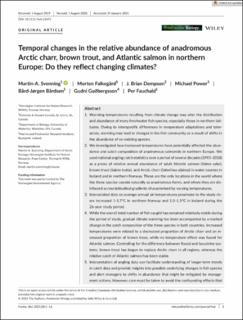Temporal changes in the relative abundance of anadromous Arctic charr, brown trout, and Atlantic salmon in northern Europe: Do they reflect changing climates?
Svenning, Martin; Falkegård, Morten; Dempson, J. Brian; Power, Michael; Bårdsen, Bård-Jørgen; Guðbergsson, Gudni; Fauchald, Per
Peer reviewed, Journal article
Published version

Åpne
Permanent lenke
https://hdl.handle.net/11250/2756557Utgivelsesdato
2021Metadata
Vis full innførselSamlinger
- Publikasjoner fra CRIStin - NINA [2397]
- Scientific publications [1423]
Sammendrag
1. Warming temperatures resulting from climate change may alter the distribution and abundance of many freshwater fish species, especially those in northern latitudes. Owing to interspecific differences in temperature adaptations and tolerances, warming may lead to changes in the fish community as a result of shifts in the abundance of co-existing species. 2. We investigated how increased temperatures have potentially affected the abundance and catch composition of anadromous salmonids in northern Europe. We used national angling catch statistics over a period of several decades (1993–2018) as a proxy of relative annual abundance of adult Atlantic salmon (Salmo salar), brown trout (Salmo trutta), and Arctic charr (Salvelinus alpinus) in water courses in Iceland and in northern Norway. These are the only locations in the world where the three species coexist naturally as anadromous forms, and where they are distributed across latitudinal gradients characterised by varying temperatures. 3. Interpolated data on average annual air temperatures proximate to the study rivers increased 1–1.7°C in northern Norway and 1.0–1.5°C in Iceland during the 26-year study period. 4. While the overall total number of fish caught has remained relatively stable during the period of study, gradual climate warming has been accompanied by a marked change in the catch composition of the three species in both countries. Increased temperatures were related to a decreased proportion of Arctic charr and an increased proportion of brown trout, while no temperature effect was found for Atlantic salmon. Controlling for the difference between fluvial and lacustrine systems, brown trout has begun to replace Arctic charr in all regions, whereas the relative catch of Atlantic salmon has been stable. 5. Interpretation of angling data can facilitate understanding of longer-term trends in catch data and provide insights into possible underlying changes in fish species and alert managers to shifts in abundance that might be mitigated by management actions. However, care must be taken to avoid the confounding effects that changes in fisheries management measures, angler preferences, and effort might have on the metrics of relative change used to make inferences about long-term trends. catch statistics, climate change, salmonids, temperature, thermal change
